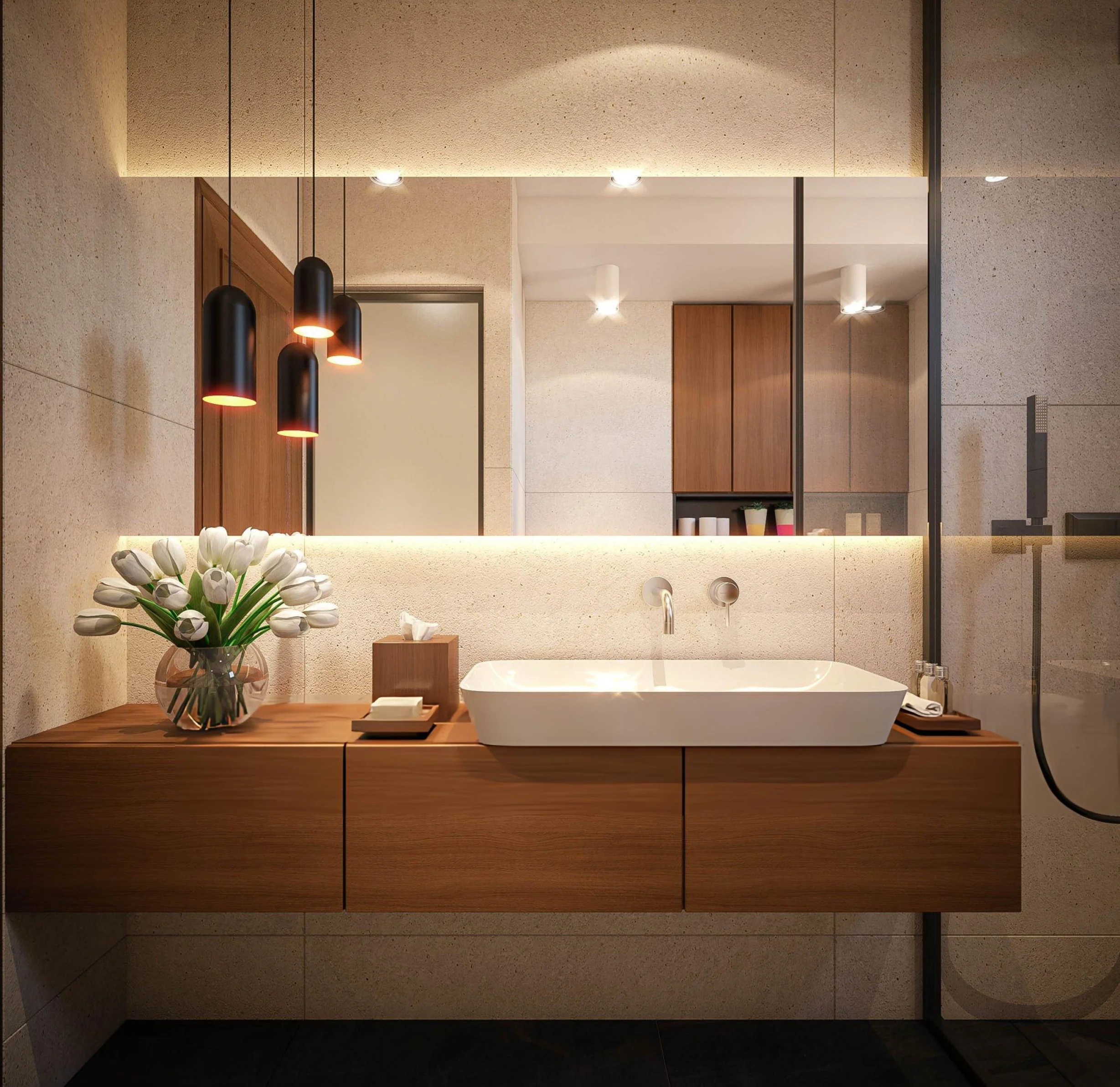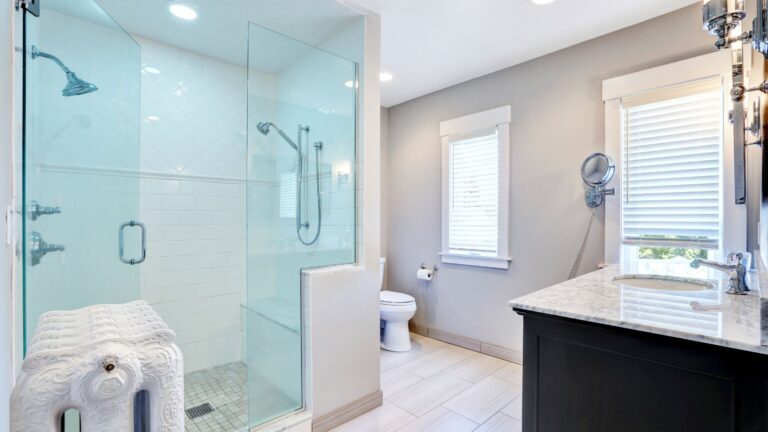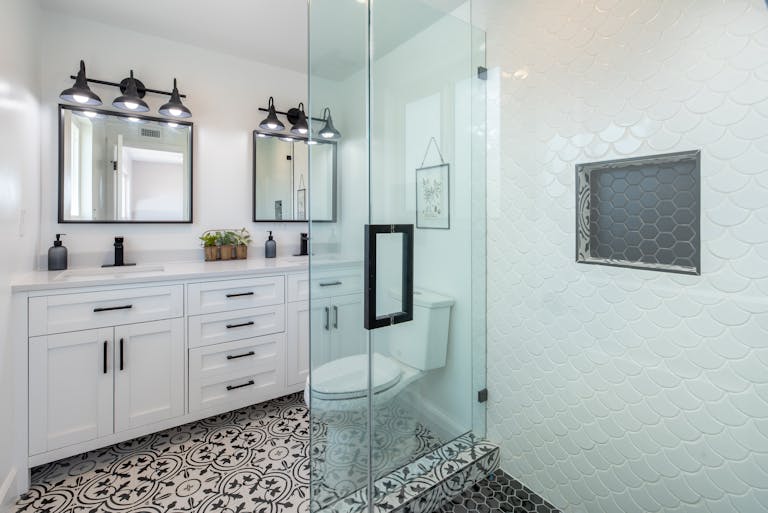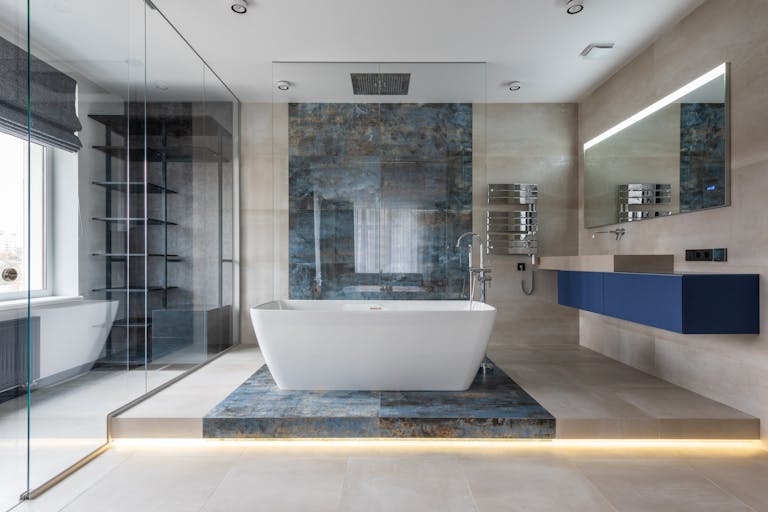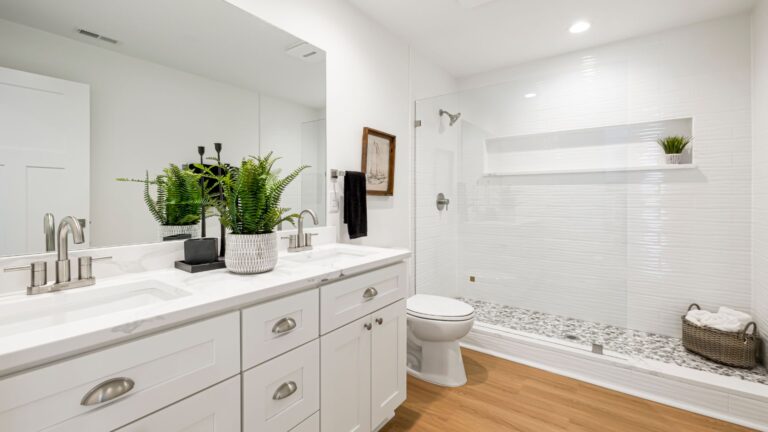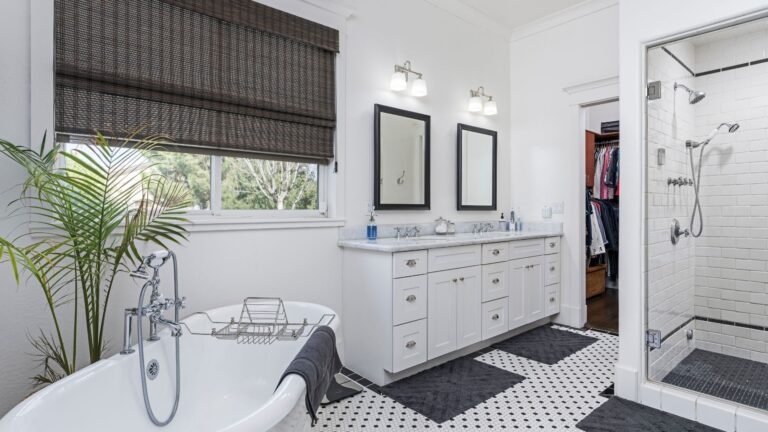Energy Efficient Lighting in Bathrooms: Sustainable and Cost-Effective Solutions
Lighting is a crucial aspect of any bathroom, not only for functionality but also for setting the right mood and ambiance. However, traditional lighting can lead to high electricity bills, especially in bathrooms where lighting is frequently used. This is where energy efficient lighting comes into play.
Switching to energy efficient lighting in your bathroom can help you save money, reduce your environmental impact, and enjoy a better lighting experience. With modern technology like LED lights, it’s easier than ever to enhance your bathroom lighting while being kind to your wallet and the planet.
In this guide, we’ll explore the benefits of energy efficient lighting, focus on LED lighting, and provide tips on how to choose the right lighting for your bathroom. From energy savings to design flexibility, making the switch to energy-efficient lighting has never been more important or more accessible.
Why Energy Efficient Lighting is Important in Bathrooms
Energy efficient lighting offers numerous benefits, not just for the environment, but for the comfort and functionality of your bathroom. The bathroom is one of the most frequently used spaces in the home, with lights often turned on multiple times a day. As a result, lighting can make up a large portion of your home’s energy consumption. By switching to energy-efficient lighting, you can reduce both your energy usage and electricity bills.
The Impact of Lighting on Energy Consumption
Lighting is responsible for a significant portion of a home’s overall energy consumption. According to the U.S. Department of Energy, lighting accounts for about 15% of the total energy usage in an average household. Bathrooms often have multiple light sources, such as overhead lighting, vanity lights, and accent lighting, making them prime candidates for energy efficient upgrades.
Switching to energy efficient lighting can drastically reduce the amount of electricity used for lighting, lowering your monthly energy bills while still providing adequate brightness and functionality.
Benefits of Energy Efficient Lighting in Bathroom Spaces
- Lower Electricity Bills: The most immediate benefit of energy efficient lighting is the reduction in energy costs. LED lights, for example, use up to 80% less energy than traditional incandescent bulbs.
- Environmental Impact: Using energy efficient lighting helps reduce your carbon footprint by lowering energy consumption. Since most electricity is still generated by burning fossil fuels, using less energy means fewer emissions from power plants.
- Improved Lighting Quality: Energy efficient lights, particularly LEDs, offer superior lighting quality. LEDs provide bright, crisp light without flickering or buzzing, making them ideal for the bathroom, where clarity and brightness are important, especially around mirrors.
- Longer Lifespan: Energy efficient lights tend to last longer than traditional incandescent or halogen bulbs. LEDs, for instance, can last up to 25 times longer than incandescent bulbs, reducing the need for frequent replacements and further cutting down on waste.
Benefits of Using LED Lighting in the Bathroom
LED (Light Emitting Diode) lighting has become the gold standard in energy efficient lighting, and for good reason. LED bulbs offer significant advantages over traditional lighting options, making them perfect for use in bathrooms.
Long Lifespan of LED Bulbs
One of the standout features of LED lighting is its long lifespan. While incandescent bulbs may last around 1,000 hours and fluorescent bulbs around 10,000 hours, LED bulbs can last up to 25,000 hours or more. This means fewer bulb replacements, lower maintenance costs, and less waste over time.
In bathrooms where lights are frequently used, LEDs are an excellent choice for longevity and consistency. You won’t need to worry about frequent bulb changes, which is especially beneficial in hard-to-reach places like above bathtubs or showers.
Energy Savings Compared to Traditional Lighting
LED lights use a fraction of the energy that traditional incandescent bulbs require. An LED bulb typically uses 80-90% less energy than an incandescent bulb, which results in significant savings on your electricity bills over time.
For example, replacing a single 60-watt incandescent bulb with a 9-watt LED can save up to $80 over the course of the bulb’s lifespan, depending on how often the light is used. In a bathroom where multiple fixtures may be running for extended periods, those savings can add up quickly.
Brightness, Quality of Light, and Design Flexibility
LED lights provide superior brightness and clarity in bathrooms. They emit bright, even light without flickering, ensuring that your bathroom is well-lit for daily tasks like shaving, makeup application, or simply getting ready in the morning.
Moreover, LED lights come in a variety of designs and can be used in many forms, such as recessed lighting, vanity lights, sconces, and even mirrors with integrated LEDs. This flexibility allows you to customize the lighting in your bathroom according to your style and functional needs.
Low Heat Emission and Safer for Bathrooms
Unlike traditional incandescent or halogen bulbs, LED lights emit very little heat. This is particularly important in bathrooms, as high temperatures can create a breeding ground for mold and mildew. LED lighting’s low heat emission makes it a safer option, especially in humid environments like bathrooms where moisture levels can fluctuate with showers and baths.
How to Choose the Right LED Lights for Your Bathroom
When selecting LED lights for your bathroom, there are several factors to consider to ensure that you get the right brightness, energy efficiency, and style for your space. Here’s a guide on how to choose the right LED lighting for your bathroom:
Factors to Consider (Size of the Bathroom, Lighting Needs, etc.)
- Room Size: The size of your bathroom plays a big role in determining how much light you need. Larger bathrooms with multiple fixtures will require more powerful lighting, while smaller bathrooms can use lower wattage or more compact LED fixtures.
- Lighting Needs: Think about the different tasks that will be done in the bathroom. For tasks like shaving or makeup application, you’ll need brighter, more direct lighting around mirrors or the vanity area. For general ambient lighting, softer lights placed in the ceiling or in the corners of the room may be sufficient.
- Placement and Layering: To create a well-lit bathroom, use a combination of different types of LED lights, such as ambient lighting, task lighting (around the vanity or shower), and accent lighting (for decorative purposes). Layering these types of lighting ensures that the room is both functional and aesthetically pleasing.
Different Types of LED Lighting for Bathrooms
There are several types of LED lights to choose from, and the right option will depend on your bathroom layout and needs:
- Recessed LED Lighting: This is ideal for general lighting in the ceiling. Recessed lighting is unobtrusive and provides an even light distribution without taking up space. It works well in bathrooms with limited ceiling height.
- LED Vanity Lights: These are perfect for illuminating your vanity or mirror area. They come in various styles, from sleek, modern designs to more traditional options, and provide bright, direct light for tasks like makeup application and grooming.
- LED Wall Sconces: For bathrooms with a more decorative or vintage style, wall sconces provide both functional and ambient lighting. They can be placed around mirrors or in other areas of the bathroom to add warmth and charm.
- LED Mirrors: Mirrors with built-in LED lights are a fantastic way to save space while providing functional lighting around your mirror. These are especially popular in modern bathrooms, offering both illumination and style.
Choosing the Correct Color Temperature for Your Bathroom Lighting
LED lights come in a variety of color temperatures, typically measured in Kelvin (K). The right color temperature can affect the mood and functionality of your bathroom:
- Warm White (2700K – 3000K): Ideal for creating a cozy, relaxing atmosphere in bathrooms. It gives off a soft, yellowish light, similar to traditional incandescent bulbs. This is great for bathrooms where you want to relax, such as near a bathtub or in the powder room.
- Cool White (4000K – 4500K): This color temperature is closer to natural daylight and provides a bright, crisp light that’s perfect for task lighting, such as around the vanity or in the shower. It helps with grooming, makeup application, and other detailed tasks.
- Daylight (5000K – 6500K): This provides a bright, blue-toned light that simulates daylight. It’s ideal for bathrooms where you want maximum visibility, especially for tasks that require accuracy, such as shaving or applying makeup. However, it may feel too harsh for relaxing areas, so use it strategically.
Fluorescent vs. LED Lighting for Bathrooms
When choosing bathroom lighting, you might be deciding between fluorescent or LED options. Both are energy efficient, but there are some important differences between the two that make LED lighting the preferred choice for most modern bathrooms.
Pros and Cons of Fluorescent Lights
- Pros:
- Cost-Effective: Fluorescent bulbs are generally cheaper than LEDs.
- Energy Efficient: They use less energy than incandescent bulbs, which makes them a more energy efficient option compared to older lighting technologies.
- Cost-Effective: Fluorescent bulbs are generally cheaper than LEDs.
- Cons:
- Shorter Lifespan: Fluorescent lights don’t last as long as LED lights. On average, they last around 8,000 hours, whereas LEDs can last up to 25,000 hours or more.
- Light Quality: Fluorescent lights can give off a harsh, cold light, which may not be ideal for bathrooms that require softer, warmer lighting.
- Environmental Impact: Fluorescent bulbs contain small amounts of mercury, which can be hazardous if the bulb breaks.
- Flickering: Over time, fluorescent lights may flicker or buzz, which can be annoying, especially in a space where you’re using the light regularly, like a bathroom.
- Shorter Lifespan: Fluorescent lights don’t last as long as LED lights. On average, they last around 8,000 hours, whereas LEDs can last up to 25,000 hours or more.
Why LED Lights Are Better for Bathrooms
- Energy Efficiency: LED lights are far more energy efficient than fluorescent lights, using up to 80-90% less energy.
- Longer Lifespan: LEDs last much longer than fluorescent lights, meaning fewer replacements and less waste.
- Quality of Light: LEDs provide brighter, more consistent light without flickering or buzzing. You can also find LEDs in a range of color temperatures, allowing you to tailor your lighting to your bathroom’s needs.
- No Harmful Chemicals: Unlike fluorescent lights, LEDs don’t contain any harmful substances like mercury, making them safer for the environment and easier to dispose of.
- Design Flexibility: LEDs offer greater flexibility in terms of design and placement. They come in a wide range of shapes, sizes, and brightness levels, allowing you to create the perfect lighting arrangement for your bathroom.
Key Features of Energy Efficient Bathroom Lighting
When selecting energy efficient lighting for your bathroom, there are a few key features that can enhance both performance and functionality.
Dimmable Switches to Control Energy Use
Dimmable LED lights allow you to adjust the brightness according to your needs, saving even more energy. For example, you might want bright, full lighting for tasks like grooming, but softer, dimmer light for relaxing baths. With dimmable lighting, you can create the perfect atmosphere while reducing electricity usage when full brightness isn’t required.
Motion Sensor Lighting for Automatic On/Off
Motion sensor lights are an excellent energy-saving feature for bathrooms. They automatically turn on when they detect motion and turn off when you leave the room, ensuring that the lights are never left on unnecessarily. This is particularly useful for bathrooms where lights may often be left on unintentionally, such as in guest bathrooms or powder rooms.
Smart Lighting Options for Remote Control and Scheduling
Smart LED lighting systems allow you to control your bathroom lights remotely via smartphone apps or voice commands. You can schedule your lights to turn on and off at specific times, adjust brightness, and even change the color temperature, all from the convenience of your phone. Smart lighting not only enhances your bathroom’s functionality but also contributes to overall energy savings.
Sustainable Lighting Design Ideas for Bathrooms
To create an energy-efficient and aesthetically pleasing bathroom, sustainable lighting design is key. By using a mix of energy-efficient lighting options, you can achieve proper illumination while also minimizing your energy consumption. Here are some ideas to help you create a beautiful, energy-efficient bathroom lighting scheme:
Layering Light with a Mix of Ambient, Task, and Accent Lighting
One of the best ways to ensure your bathroom lighting is both functional and stylish is by layering different types of lighting. By combining ambient, task, and accent lighting, you can create a well-lit space that suits your needs while being energy-efficient.
- Ambient Lighting: This is your primary light source, providing overall illumination to the room. Ceiling-mounted LED fixtures or recessed lights are ideal for this role. Make sure you use an energy-efficient LED bulb with the appropriate CFM for the room size to avoid wasting energy.
- Task Lighting: Task lighting is essential for areas like mirrors and vanities, where you need focused, bright light. Use LED vanity lights or wall-mounted fixtures around the mirror for even, shadow-free lighting. Dimmable lights are great for adjusting brightness during tasks like makeup application or shaving.
- Accent Lighting: Accent lighting adds a decorative touch and can help set the mood in the bathroom. Use LED strips under cabinets, along shelves, or inside glass shower enclosures to create a soft glow that enhances the overall design without consuming much energy.
How to Create a Well-Lit and Energy-Efficient Bathroom Design
To create an energy-efficient design, think about the positioning of your lighting fixtures. Make use of natural light whenever possible. Large windows or skylights can reduce the need for artificial lighting during the day, helping to lower your energy consumption.
For energy efficiency, focus on task lighting near mirrors and sinks, where bright light is essential, and use ambient lighting sparingly. Install fixtures that provide ample lighting for everyday use without overpowering the space.
Smart Lighting is another sustainable option for bathroom lighting. Automated lighting systems, such as motion sensors or timers, allow lights to turn on and off automatically, which ensures lights are never left on unnecessarily.
Energy-Saving Lighting Tips for Your Bathroom
Making small adjustments to your bathroom lighting can significantly reduce energy use while still providing excellent illumination. Here are some practical tips to help you maximize the efficiency of your lighting:
How to Position Lighting Fixtures for Maximum Efficiency
- Use recessed lighting for general illumination, as it’s efficient and provides a clean, modern look. Ensure these lights are properly aligned to cover the entire bathroom space without using unnecessary fixtures.
- Place task lighting directly around mirrors and vanity areas to ensure adequate lighting for grooming tasks. This targeted lighting reduces the need for overhead lights to be on at full power.
- Consider wall-mounted sconces near the mirror for a more energy-efficient and stylish alternative to overhead lighting.
Choosing the Right Wattage for Your Bathroom Lights
Even with energy-efficient LEDs, it’s important not to overestimate the wattage needed. Choosing the appropriate wattage can help ensure you aren’t wasting energy. For instance, a standard LED bulb of 9-12 watts can provide sufficient light for most bathroom tasks, replacing traditional 60-75 watt incandescent bulbs.
When choosing the right wattage, remember that bathroom lighting needs vary depending on the size of the space. Use the CFM and square footage guidelines to determine how much lighting is necessary for the room.
Regular Maintenance to Ensure Lighting Efficiency
To keep your energy-efficient lights working at their best, regular maintenance is key. Dust and dirt can accumulate on light fixtures, reducing their brightness and efficiency. Clean your light fixtures regularly to maintain maximum light output.
Also, check your bulbs for any signs of wear, and replace them promptly. Even energy-efficient lights lose their effectiveness when they’re nearing the end of their lifespan, so timely replacements can help keep your energy consumption low.
Cost-Effectiveness of Energy-Efficient Lighting in the Bathroom
Investing in energy-efficient lighting may seem like a higher upfront cost, but it quickly pays for itself through reduced energy consumption and lower electricity bills. The long lifespan of LEDs and the reduced need for frequent bulb replacements make them a smart investment.
How Much Money You Can Save by Switching to LED Lighting
Replacing traditional incandescent bulbs with LEDs can result in significant savings. For example, if you replace a 60-watt incandescent bulb with a 9-watt LED, you can save up to $80 over the lifespan of the bulb. If your bathroom has multiple light fixtures, the savings quickly add up.
Switching to LED lighting can cut your energy consumption by 80-90%, leading to reduced electricity costs over time. In bathrooms where lighting is used frequently, these savings can be substantial.
Return on Investment with Energy-Efficient Lights
While the initial cost of LED bulbs may be higher than traditional bulbs, the return on investment is clear. With longer lifespans and lower energy use, LEDs typically pay for themselves within one year. In the long run, they continue to save you money by reducing your household’s energy demands.
Incentives and Rebates for Using Energy-Efficient Products
Many utility companies and local governments offer incentives, rebates, and tax credits for switching to energy-efficient lighting. These programs can help offset the initial cost of upgrading your bathroom lighting, making it even more affordable. Check with your local utility company to see what options are available in your area.
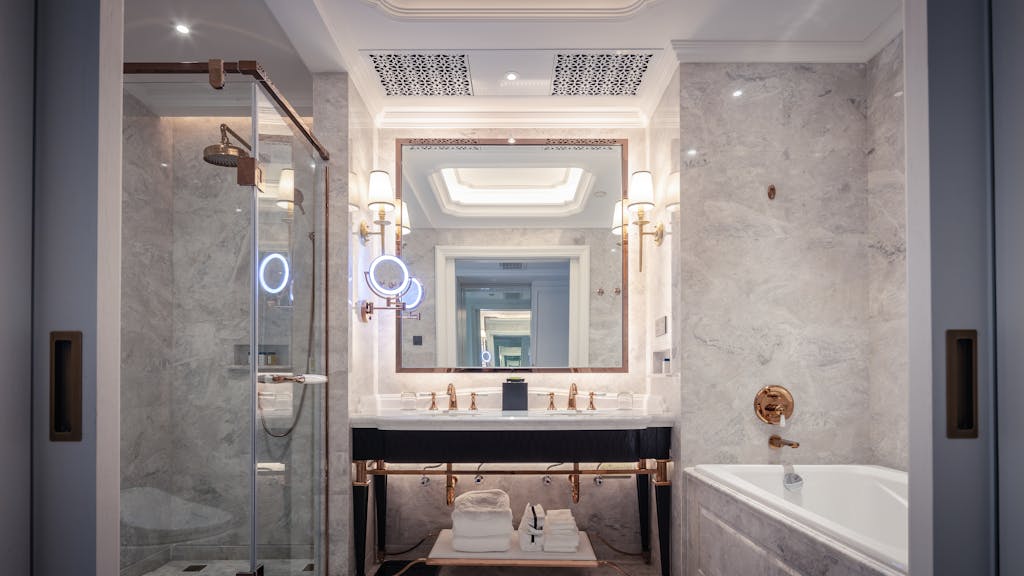
Conclusion: Energy-Efficient Lighting in Bathrooms
Energy-efficient lighting in your bathroom is an easy way to reduce your carbon footprint, lower your electricity bills, and improve the functionality of the space. By switching to LED lights, using the correct wattage, and ensuring proper fixture placement, you can achieve an energy-efficient bathroom that meets your needs without unnecessary energy waste.
With the added benefits of long-lasting bulbs, reduced environmental impact, and improved lighting quality, making the change to energy-efficient lighting is a win-win.
Contact Us for a Free Consultation
If you’re ready to upgrade your bathroom lighting to energy-efficient LED options or need help with installation, we’re here to assist you. Contact us today for a free consultation, and let’s ensure your bathroom is bright, beautiful, and energy-efficient.

